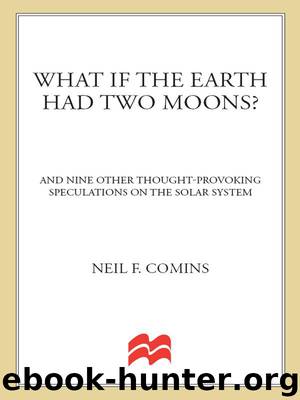What If the Earth Had Two Moons?: And Nine Other Thought-Provoking Speculations on the Solar System by Comins Neil F

Author:Comins, Neil F. [Comins, Neil F.]
Language: eng
Format: mobi
Publisher: St. Martin's Press
Published: 2010-03-29T16:00:00+00:00
Why Stars with Different Amounts of Matter
Have Different Lifetimes
As just noted, more massive stars live for much shorter lengths of time than do less massive ones. A 25 M star will shine for about eight million years, whereas our (1 M) Sun will shine for about ten billion years. It is important to understand the evolution of stars and how they change the chemistry of the interstellar medium, the gas and dust from which future generations of stars, including Futura’s star, are formed.
Recall from earlier in this chapter that the Big Bang explosion caused the early formation of hydrogen, helium, and lithium. However, there are 92 naturally occurring elements today. Therefore, all of the atoms of the other 89 elements, as well as some helium and most of the lithium that exist today, had to have been created after the Big Bang. In fact, they were, and still are, created deep inside stars. Here is how that works.
When a small piece of an interstellar cloud of gas and dust collapses to form a star, that matter is mostly hydrogen and helium that had been created in the Big Bang. As this gas piles up on itself to form the star, the gravitational attraction of all this matter compresses the center of the star. This compression causes the temperature of the gas in the core to soar. When it exceeds 10 million K (18 million°F), the hydrogen atoms can fuse together, creating helium, just as was done during the Big Bang.
This fusion in the star’s core is accompanied by the release of energy in the form of gamma ray photons.* Colliding with other atoms, these photons lose energy until they emerge from the star’s surface layer as starlight. The energy that we see as sunlight, for example, was created by fusion in the Sun’s core over 100,000 years ago.
So, the fusion occurring in stars like the Sun is converting core hydrogen into helium. When the core is pure helium, it begins fusing into carbon and oxygen. At the same time this is occurring, a shell of hydrogen surrounding the core will be fusing into helium, and that helium will eventually fuse into carbon and oxygen, too. After the core is all carbon and oxygen, stars with masses similar to that of the Sun shed their outer layers, now enriched with helium, carbon, and oxygen from the fusing shells, in mild “explosions” called planetary nebulae. Clearly, the fusion that occurred in the star results in the debris that returns to the interstellar medium having less hydrogen than the gas from which the star formed. The cores of such stars remain intact. They are called white dwarfs.
Elements with more protons, called heavy elements, are created in stars with more mass than about 9 M As with lower-mass, Sunlike stars, fusion begins in their cores, converting hydrogen into helium. When the core hydrogen is used up, a shell of hydrogen surrounding the core begins fusing hydrogen into helium, and the core fuses its helium into carbon and oxygen.
Download
This site does not store any files on its server. We only index and link to content provided by other sites. Please contact the content providers to delete copyright contents if any and email us, we'll remove relevant links or contents immediately.
| Aeronautics & Astronautics | Astronomy |
| Astrophysics & Space Science | Comets, Meteors & Asteroids |
| Cosmology | Mars |
| Solar System | Star-Gazing |
| Telescopes | UFOs |
Tools of Titans by Timothy Ferriss(8214)
Turbulence by E. J. Noyes(7935)
Secrets of Antigravity Propulsion: Tesla, UFOs, and Classified Aerospace Technology by Ph.D. Paul A. Laviolette(5309)
Astrophysics for People in a Hurry by Neil DeGrasse Tyson(5130)
Room 212 by Kate Stewart(5035)
Design of Trajectory Optimization Approach for Space Maneuver Vehicle Skip Entry Problems by Runqi Chai & Al Savvaris & Antonios Tsourdos & Senchun Chai(5011)
Pale Blue Dot by Carl Sagan(4907)
The David Icke Guide to the Global Conspiracy (and how to end it) by David Icke(4624)
A Journey Through Divination and Astronomy by Publishing Pottermore(4341)
Goodbye Paradise(3724)
Apollo 8 by Jeffrey Kluger(3635)
COSMOS by Carl Sagan(3553)
Losing the Nobel Prize by Brian Keating(3498)
The Five People You Meet in Heaven by Mitch Albom(3474)
How to Read Water: Clues and Patterns from Puddles to the Sea (Natural Navigation) by Tristan Gooley(3406)
Brief Answers to the Big Questions by Stephen Hawking(3369)
How to Read Nature by Tristan Gooley(3249)
The Order of Time by Carlo Rovelli(3144)
A Brief History of Time by Stephen Hawking(2959)
